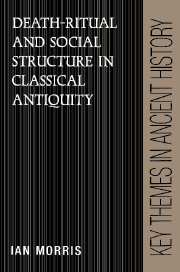Book contents
- Frontmatter
- Contents
- List of figures
- List of tables
- Preface
- Abbreviations
- 1 Map of sites in the Roman empire discussed in this book
- 2 Map of sites in Greece discussed in this book
- 1 The anthropology of a dead world
- 2 ‘Mos Romanus’: cremation and inhumation in the Roman empire
- 3 ‘Dem bones’: skeletal remains
- 4 Taking it with you: grave goods and Athenian democracy
- 5 Monuments to the dead: display and wealth in classical Greece
- 6 Famous last words: the inscribed tombstone
- 7 At the bottom of the graves: an example of analysis
- 8 Conclusion
- Bibliographical essay
- Bibliography
- Index
5 - Monuments to the dead: display and wealth in classical Greece
Published online by Cambridge University Press: 02 December 2009
- Frontmatter
- Contents
- List of figures
- List of tables
- Preface
- Abbreviations
- 1 Map of sites in the Roman empire discussed in this book
- 2 Map of sites in Greece discussed in this book
- 1 The anthropology of a dead world
- 2 ‘Mos Romanus’: cremation and inhumation in the Roman empire
- 3 ‘Dem bones’: skeletal remains
- 4 Taking it with you: grave goods and Athenian democracy
- 5 Monuments to the dead: display and wealth in classical Greece
- 6 Famous last words: the inscribed tombstone
- 7 At the bottom of the graves: an example of analysis
- 8 Conclusion
- Bibliographical essay
- Bibliography
- Index
Summary
Whether you are a townsman or a stranger coming from elsewhere,
Take pity as you go by on Tetichos, a good man.
Falling in war, he lost his fresh youth.
Mourn for these things, and go on to good fortune.
(IG I3 1194 bis (CEG 13), Attica, mid-sixth century b.c.)Eight hundred years later, Ulpian ruled that a funerary monument was by law ‘something which exists to preserve memory’ (D 11.7.2.6). The continuity is striking, but so too are the changes in the functions of monuments. I use most of this chapter to continue the story of display in classical Athens, concentrating on cycles of lavishness and restraint. Grave goods and grave markers are very different kinds of display, the first seen mainly by those taking part in the funeral, the second by those who come later. A Thasian inscription of about 500 b.c. makes this explicit, saying ‘Whoever was not present when they carried me out in death, let him now lament me; the memorial of Telephanes’ (CEG 159]. However, both forms of display are (with a few exceptions) created by the buriers in the ritual process of disposing of the dead, and can only be understood in terms of each other. I argue that they offer a framework around which to organise a history of social structure.
GRAVE MARKERS AND DEMOCRACY, AND BEYOND
Sixth-century Athenian grave markers are impressive: massive, blocked-out kouroi, fetching millions on the art market, even when their authenticity is suspect; slender stelai topped with sphinxes; or huge mounds like that for Cimon, probably murdered by the tyrant family in 528/7 b.c. (Hdt. 6.103.3).
- Type
- Chapter
- Information
- Death-Ritual and Social Structure in Classical Antiquity , pp. 128 - 155Publisher: Cambridge University PressPrint publication year: 1992



